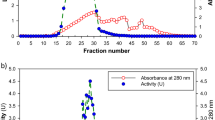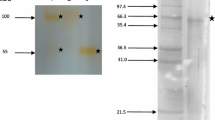Abstract
Of fourteen natural isolates of Trichoderma, no correlation was found between substrate weight loss and phenol oxidase (PO) activity in rice straw cultures. The highest PO producer from these laccase-positive strains was subjected to UV mutagenesis in order to select high and low PO activity mutants. There was no significant difference in substrate weight loss for mutant strains with six times higher and six times lower PO activity than the parent strain. Nor did the enzyme activity result in decreased growth inhibition by inhibitory phenolic compounds. PO enzyme from the parent Trichoderma and one of its high-PO-activity mutants was subsequently purified by ethanol precipitation from liquid cultures optimized by supplementation with copper sulphate and cycloheximide. Protein staining and activity staining of disc electrophoresis gels showed that only one PO enzyme of approximately 71 000 Da was produced. The enzyme could be defined as a laccase (benzenediol: oxygen oxidoreductase E.C. 1.10.3.2) because it catalysed the oxidation of syringaldazine and p-phenylenediamine in the absence of hydrogen peroxide, and because it was inhibited by cetyltrimethylammonium because but not by cinnamic acid. No specific in-vivo function could be assigned to this enzyme.
Similar content being viewed by others
References
Alexopoulos CJ, Mims CW (eds) (1979) Introductory mycology, 3rd edn. Wiley, New York
Bollag JM, Leonowicz A (1984) Comparative studies of extracellular fungal laccases. Appl Environ Microbiol 48:849–854
Bollag J-M, Shuttleworth KL, Anderson DH (1988) Laccase-mediated detoxification of phenolic compounds. Appl Environ Microbiol 54:3086–3091
Bourbonnais R, Paice MG (1990) Oxidation of non-phenolic substrates. An expanded role for laccase in lignin biodegradation. FEBS Lett 267:99–102
Davis BJ (1964) Disc electrophoresis. II. Method and application to human serum proteins. Ann NY Acad Sci 121:404–427
Evans CS (1985) Laccase activity in lignin degradation by Coriolus versicolor in vivo in vitro studies. FEMS Microbiol Lett 27:339–343
Flegel TW, Meevootisom V, Kiatpapan S (1982) Indications of lignonilysis by Trichoderma strains isolated from soil during silmultaneous screening for fungi with cellulase and laccase activity. J Ferment Technol 60:473–475
Froehner SC, Eriksson K-E (1974) Induction of Neurospora crassa laccase with protein synthesis inhibitors. J Bacteriol 120:450–457
Haars A, Huttermann A (1980) Function of laccase in the whiterot fungus Fomes annosus. Arch Environ Microbiol 48:849–854
Harkin JM, Obst JR (1973) Syringaldazine, an effective reagent for detecting laccase and peroxidase in fungi. Experientia 29:381–387
Huber M, Lerch K (1987) The influence of copper on the induction of tyrosinase and laccase in Neurospora crassa. FEBS Lett 219:335–338
Kersten PJ, Kalyanaraman B, Hammel KE, Reinhammar B, Kirk TK (1990) Comparison of lignin peroxidase, horseradish peroxidase and laccase in the oxidation of methoxybenzenes. Biochem J 268:475–480
Leonowicz A, Szklarz G, Wojtas-Washilewska M (1985) The effect of fungal laccase on fractionated lignosulphonates (peritan Na). Phytochemistry 24:393–396
Lowry OH, Rosebrough NJ, Farr AL, Randall RJ (1951) Protein measurement with the Folin phenol reagent. J Biol Chem 193:265–275
Lundquist K, Kristersson P (1985) Exhaustive laccase-catalysed oxidation of a lignin model compound (vanillyl glycol) produces methanol and polymeric quinoid products. Biochem J 229:277–279
Marbach I, Harel E, Mayer AM (1985) Pectin, a second inducer for laccase production by Botrytis cinerea. Phytochemistry 24:2559–2561
Mayer AM (1987) Polyphenol oxidases in plants — recent progress. Phytochemistry 26:11–20
Meevootisom V, Flegel TW, Glinsukon T, Sobhon N, Kiatpapan S (1984) Screening for and asolation of lignocellulolytic fungi from Thailand for animal feed production. J Sci Soc Thailand 10:147–178
Onions AHS, Allsopp D, Eggings HOW (1981) Smith's introduction to industrial mycology, 7th ed. Edward Arnold, London, p 366
Saunders PR, Sui RGH, Genest RN (1948) A cellulolytic enzyme preparation from Myrothecium verrucaria. J Biol Chem 174:697–703
Tsao GT, Chiang L-C (1983) Cellulose and hemicellulose technology. In: Smith JE, Berry DR, Kristiansen B (eds) The filamentous fungi, vol 4, Edward Arnold, London, pp 296–326
Walker JRL, McCallion RF (1980) The selective inhibition of ortho-and para-diphenol oxidases. Phytochemistry 19:373–377
Author information
Authors and Affiliations
Additional information
Correspondence to: T. W. Flegel
Rights and permissions
About this article
Cite this article
Assavanig, A., Amornikitticharoen, B., Ekpaisal, N. et al. Isolation, characterization and function of laccase from Trichoderma . Appl Microbiol Biotechnol 38, 198–202 (1992). https://doi.org/10.1007/BF00174468
Received:
Accepted:
Issue Date:
DOI: https://doi.org/10.1007/BF00174468




